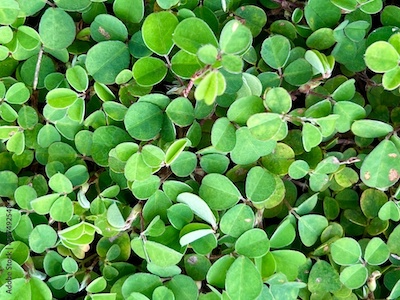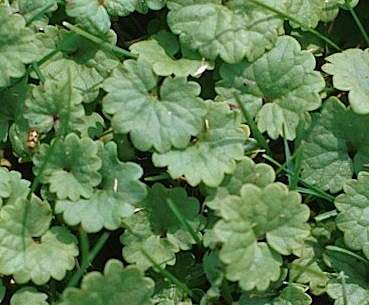Establishing Tall Fescue/Microclover Lawns
by Brian Lathrop, Fairfax Master Gardener

Microclover closeup
In an earlier article, I discussed adding microclover (e.g., Trifolium repens L. var. Pirouette or Miniclover®) inoculated with Rhizobia bacteria to a sward of tall fescue (Festuca arundinacea) to reduce or perhaps even eliminate the need for nitrogen fertilizers. Nitrogen fertilizers must be added at 1 to 2 pounds per 1000 square feet to maintain the density of a sward of tall fescue, even if clippings are recycled. Rhizobia can establish nodules on the clover roots, where they can fix as much as 30 percent of total nitrogen fixed by the soil microbiome. In a mixed tall fescue/clover sward, Rhizobia can fix 1 to 2 pounds of nitrogen per 1000 square feet. I speculated in 2022 that the steady fertilization provided by biological nitrogen fixation would make the mixed sward more resistant to weeds. With this article, I revise my recommendations with the benefit of more research and experience.
Nitrogen Fertilizers
The health of a low-input mixed sward depends on efficient biological nitrogen fixation; however, excessive nitrate fertilization suppresses nodulation and biological nitrogen fixation. This eventually can lead to compacted, infertile soil that cannot support a dense sward. Unfortunately, homeowners do not have the tools available to measure biological nitrogen fixation or the overall health of the soil microbiome. For now, I assume that 1 pound of nitrogen per 1000 square feet (recycling clippings) annually will maintain the density of the mixed sward without critically interfering with nodulation or biological nitrogen fixation.

Ground ivy leaf
Weed Pressure and Herbicides
In my earlier report, I speculated that the steady fertilization provided by microclover would make the mixed sward more resistant to weeds. Intense pressure from both cool-season and warm-season annual weeds that thrive in our transition zone, however, still provides a major challenge to establishing a mixed sward. Clover cannot help a sparse tall fescue sward outcompete ground ivy, Japanese stiltgrass, mock strawberry, dandelions, violets or chickweed. (These weeds also thwarted my earlier attempts to establish an all-clover lawn.)
All commonly used herbicides hurt clover, but perhaps herbicides could be used to help establish a dense sward of tall fescue before adding clover. Unfortunately, evidence is accumulating that “non-target effects” of herbicides include distortion and potential destruction of the soil microbiome. The homeowner again has no way of knowing whether herbicides have critically degraded the health of the soil microbiome before overseeding with clover. Given current evidence, though, homeowners should avoid herbicides altogether, unless proven by field trials not to degrade the soil microbiome.
Best Practices
Establishing a dense, mixed sward without herbicides is a challenge. A promising strategy involves judicious timing of tall fescue and microclover seeding, the use of leaf mulch to engage the soil microbiome while protecting seeds and timely mechanical removal of problematic weed stands.
Tall fescue and Miniclover are planted in the fall as soon as the soil temperature falls below 72 F and the 10-day forecast shows no impending heat waves. Good contact between new seeds and the soil is essential: set the mower deck to its lowest setting, collect clippings and leaf debris and remove thatch and weeds with a dethatching rake.
To ensure the densest, most competitive sward, tall fescue seeds are planted at the distributers’ recommended establishment rates (not overseeding rates). Nitrogen is provided at 1 pound per 1000 square feet using nitrogen-coated tall fescue seeds, for example. Add freshly inoculated Miniclover® at or below the recommended overseed rate, depending on the coverage of clover before dethatching. (Clover will come back in a few weeks after dethatching.)
Seeds are covered with a one-quarter inch layer of certified leaf compost, which can be spread easily using the back of a metal rake. This step is essential to keep seeds moist, while still allowing enough sunlight for germination. The compost also replaces lost biomass and nourishes the soil microbiome, while protecting newly germinated seedlings during heat waves. It also serves to secure seeds against watering and heavy rain on 15-degree slopes. Water the lawn lightly for about 10 days until germination or as necessary during late season heat waves.
The nitrogen fertilization promotes early germination of chickweed and reinvigorates dandelions, violets and mock strawberry. Tall fescue seeded at an establishment rate and mowed at three inches appears to be outcompeting dispersed chickweed. But, if chickweed mats or other broadleaf weeds have overrun the new sward by mid-October, it may be necessary to remove the weeds mechanically and overseed with another round of tall fescue. If the ground temperature is too cool for fescue germination by then, the seeds may remain dormant until next spring.
Despite these problems, fall seeding is the homeowner’s best and probably only hope for establishing a dense mixed sward. The same weeds mentioned above also can interfere with spring planting by creating openings in the sward for later infestation with annual summer weeds, like stiltgrass. Further, spring fertilization predisposes tall fescue to fungal disease in the summer and invigorates ground ivy growth, which can rapidly smother the sward.
Conclusion
Despite weed pressure and uncertainties about biological nitrogen fixation, a mixed sward of even moderate density has shown high productivity since the fall of 2022. It has shown excellent tolerance to heat and drought; irrigation was not required to sustain growth or to maintain a deep green color. The mixed sward has nourished an abundance of ground bees, earthworms, ants, beetles, spiders, salamanders, squirrels and even deer, which have used the mixed sward as forage. Invasive weeds, particularly ground ivy, have been and doubtless will continue to be a problem, but each overseeding appears to result in a denser sward. Altogether, the mixed sward shows real promise at a time when preserving soil health and ecological diversity is more of an imperative than propping up a weed-free, monoculture lawn with harmful chemicals.
Resources
• The Promise of a Low-Input Tall Fescue Microclover Lawn, Brian Lathrop, Fairfax Gardening
• Fertilizing the Lawn, Joseph Heckman and James Murphy, Rutgers Cooperative Research &
Extension, Fact Sheet FS633
• Ecosystem Consequences of Herbicides: The Role of Microbiome, Suvi Ruuskanen et al.,
Department of Biological and Environmental Science, University of Jyväskylä, Finland